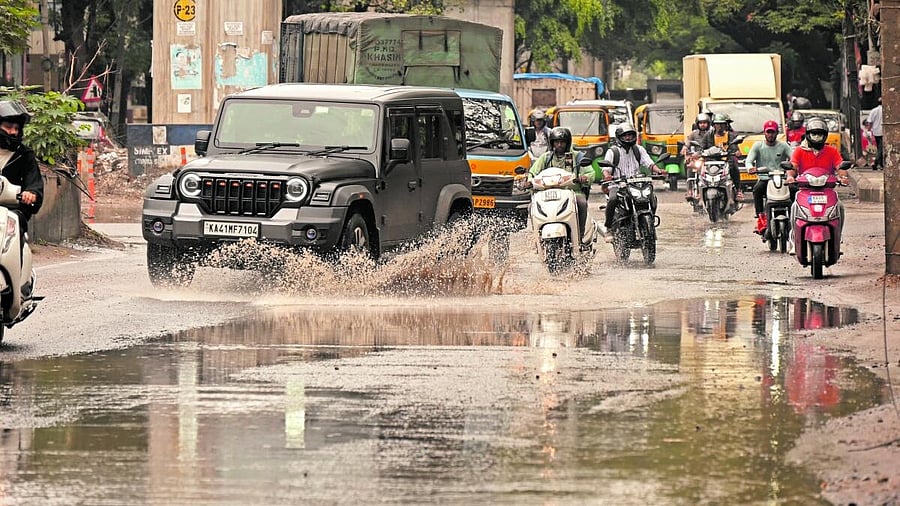
Vehicles wade through waterlogged on 100 feet road, Koramangala in Bengaluru on Tuesday, 20 May 2025.
Credit: DH photo
Last week's heavy downpour once again turned Manyata Tech Park into a lake. As if that flooding wasn’t enough, the tech park was submerged again on Monday morning--at some points, under two feet of water. A similar situation occurred less than eight months ago.
Routine rains flooding the tech park are a clear call for Bengaluru’s tech giants and real estate groups to rethink urban design.
Manyata Tech Park sits squarely in the Hebbal-Nagavara valley, just below Nagavara and Rachenahalli lakes. Water naturally flows through the tech park to reach downstream lakes like Kalkere. These once-expansive lakes and drains were meant to manage seasonal runoff. Today, however, the city’s drains carry a perennial flow – thanks to both treated and untreated wastewater. As Bengaluru is increasingly paved over with concrete and built surfaces, rainfall no longer seeps into the soil. Instead, it rushes into overloaded drains that lack the capacity to handle it. Simply increasing the size and quantity of the drains will only push the flooding further downstream.
More grey infrastructure is not the solution. Storm water must be captured, stored, and gradually released or infiltrated into the ground. This process, in fact, is what natural systems-- streams and lakes--are designed to do. By adopting innovative solutions inspired by nature, Manyata can not only address its flooding issues but also contribute to groundwater recharge in an area already suffering from depletion.
Bengaluru has a history of collaborative urban problem solving. Initiatives like Tender S.U.R.E, which delivered better designed roads, began as public-private pilots before being adopted by the government. Corporate sustainability initiatives sponsor lake rejuvenation efforts across the city. Similarly, Bengaluru’s tech and real estate leaders now have an opportunity to demonstrate how nature-based solutions can transform a managed, controlled area like Manyata.
Globally, nature-based solutions are being used to tackle climate challenges such as water scarcity, drought, heat, and flooding. In Kigali, Rwanda, for example, a study showed that combining nature-based solutions with resized hydraulic structures reduced flood-prone areas by about 70% to 100%. Lakes, wetlands, and infiltration trenches can be used to treat wastewater and promote groundwater recharge. Green roofs and urban forests can reduce heat and cooling costs while capturing carbon. Rain gardens, bioswales, and retention tanks can absorb rainwater and prevent flooding. Nature-based solutions can complement conventional grey infrastructure like sewage treatment plants and stormwater drains.
At Manyata Tech Park, a comprehensive plan would require multiple, interconnected interventions and significant investment. During intense rain, ankle- to knee-deep water has accumulated across the 300-acre campus — equivalent to 50-150 Olympic-sized swimming pools. With thoughtful natural solutions, this water can be captured and stored within the available space. Rain gardens can be installed under flyovers and in open spaces, allowing water to infiltrate the ground or pool temporarily. Large road dividers can be redesigned as canals to hold water, with reedbeds for filtration. A sluice gate at the end of each canal can slowly release water into drains, reducing the risk of downstream flooding. Bioswales – made of vegetation, mulch, bioretention soil, gravel, and perforated pipes-- can treat and delay water flow along roadsides and highways, reducing runoff and improving water quality.
Mayata's commercial buildings also offer potential. Green roofs and walls can help capture rainwater and reduce urban heat while supplying non-potable water for daily use, lessening pressure on groundwater sources. Permeable pavements and infiltration trenches can further reduce surface runoff and support groundwater recharge.
To prevent Manyata Tech Park from becoming a biannual flood zone, we must seize this opportunity to showcase the promise of nature-based solutions. The campus can become a model for urban flood management in Bengaluru, demonstrating how to handle large volumes of water quickly and sustainably. By shifting away from concrete and investing in natural systems, Manyata can tackle the recurring flooding and related climate challenges in the long term.
With coordinated action among city planners, designers, corporate leaders and government bodies, Manyata could lead the way in mainstreaming nature-based infrastructure in Bengaluru. It could help set new standards for blue-green infrastructure – applicable across the city and beyond. Rather than being known for rapid urbanisation, population growth, and poor planning, Bengaluru can reclaim its fame for a well-planned water management system.
(The writers are researchers at WELL Labs, a not-for-profit water systems research and innovation centre)